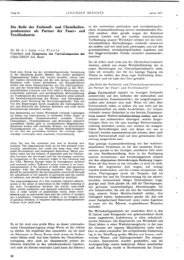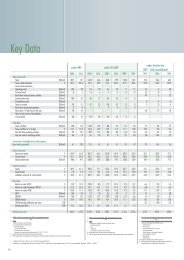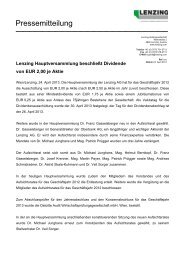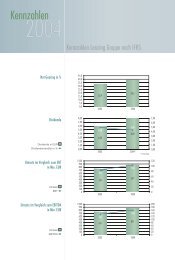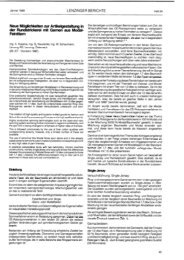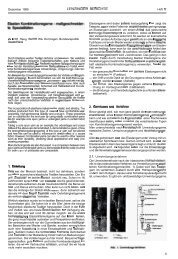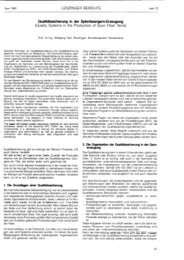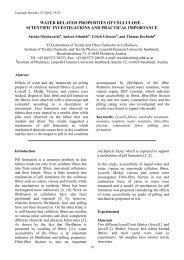Production of spruce dissolving pulp with the - Lenzing
Production of spruce dissolving pulp with the - Lenzing
Production of spruce dissolving pulp with the - Lenzing
Create successful ePaper yourself
Turn your PDF publications into a flip-book with our unique Google optimized e-Paper software.
<strong>Lenzing</strong>er Berichte, 83 (2004) 24-34<br />
PRODUCTION OF SPRUCE DISSOLVING PULP WITH THE<br />
PREHYDROLYSIS-ALKALINE SULFITE PROCESS (PH-ASA)<br />
Introduction<br />
O. Kordsachia, S. Roßkopf, R. Patt<br />
Institute for Wood Chemistry and Chemical Technology <strong>of</strong> Wood and<br />
Department <strong>of</strong> Wood Science, Section Chemical Technology <strong>of</strong> Wood<br />
Leuschnerstraße 91<br />
D-21031 Hamburg<br />
e-mail: o.kordsachia@holz.uni-hamburg.de<br />
Kraft and soda/AQ <strong>pulp</strong>ing are wellestablished<br />
technologies for paper <strong>pulp</strong><br />
production. With preceding acid<br />
hydrolysis (PH) <strong>the</strong> kraft process is also<br />
used for <strong>dissolving</strong> <strong>pulp</strong> production. The<br />
simple soda process is preferentially<br />
applied to nonwoods, but as PH-Soda/AQ<br />
process also appropriate for production <strong>of</strong><br />
<strong>dissolving</strong> <strong>pulp</strong>s from hardwoods. The<br />
alkaline sulfite <strong>pulp</strong>ing process <strong>with</strong><br />
addition <strong>of</strong> anthraquinone and methanol<br />
(ASAM) was developed initially as an<br />
alternative to <strong>the</strong> kraft process for <strong>the</strong><br />
production <strong>of</strong> paper <strong>pulp</strong>s. With a<br />
prehydrolysis stage, this process can also<br />
be used to produce high-grade <strong>dissolving</strong><br />
<strong>pulp</strong>s [1-4]. Up to now, this process has<br />
not been implemented on an industrial<br />
scale mainly due to problems caused by<br />
<strong>the</strong> presence <strong>of</strong> methanol in this process. It<br />
requires an explosion pro<strong>of</strong> digester house<br />
and methanol recovery facilities. We have<br />
tried to eliminate methanol <strong>with</strong>out losing<br />
<strong>the</strong> distinct advantages <strong>of</strong> <strong>the</strong> ASAM<br />
<strong>pulp</strong>ing process. Without methanol, <strong>the</strong><br />
extent <strong>of</strong> delignification is considerably<br />
reduced. This loss in delignification<br />
efficancy can be compensated for by<br />
changing <strong>the</strong> Na2SO3:NaOH ratio and <strong>the</strong><br />
mode <strong>of</strong> NaOH addition. A high<br />
percentage <strong>of</strong> sodium sulfite in <strong>the</strong> total<br />
chemical charge - as applied in ASAM<br />
cooking - provides <strong>the</strong> process <strong>with</strong> high<br />
selectivity in lignin removal. With increased<br />
sodium hydroxide percentage<br />
delignification is improved at <strong>the</strong> expense<br />
<strong>of</strong> selectivity. A high charge <strong>of</strong> sodium<br />
hydroxide results in an enhanced<br />
24<br />
carbohydrate degradation, especially in <strong>the</strong><br />
initial cooking phase. It was possible to<br />
demonstrate that <strong>the</strong> results <strong>of</strong> alkaline<br />
sulfite/AQ <strong>pulp</strong>ing <strong>with</strong> increased NaOH<br />
percentage in <strong>the</strong> total chemical charge can<br />
be substantially improved when <strong>the</strong> NaOH<br />
charge is split: one part is added to <strong>the</strong><br />
impregnation liquor and ano<strong>the</strong>r part is<br />
added when <strong>the</strong> maximum cooking<br />
temperature has been reached. In s<strong>of</strong>twood<br />
<strong>pulp</strong>ing this NaOH splitting has a tw<strong>of</strong>old<br />
effect: <strong>the</strong> <strong>pulp</strong> viscosity increases and<br />
simultaneously delignification is extended.<br />
With this so-called ASA process we were<br />
able to obtain results similar to those<br />
achieved in ASAM <strong>pulp</strong>ing [5]. This was<br />
<strong>the</strong> starting point for our investigations on<br />
ASA <strong>pulp</strong>ing <strong>with</strong> prehydrolysis for<br />
production <strong>of</strong> <strong>dissolving</strong> <strong>pulp</strong>s.<br />
Optimization <strong>of</strong> different alkaline<br />
<strong>dissolving</strong> <strong>pulp</strong> processes<br />
In order to explore <strong>the</strong> potential <strong>of</strong> <strong>the</strong><br />
ASA process for production <strong>of</strong> <strong>dissolving</strong><br />
<strong>pulp</strong> grades, s<strong>of</strong>twood (<strong>spruce</strong>) was chosen<br />
as raw material, because it is more difficult<br />
to <strong>pulp</strong> than hardwood. This study<br />
comprised three parts: first <strong>the</strong> modified<br />
AS/AQ process <strong>with</strong> prehydrolysis stage<br />
(PH-ASA) was optimized, <strong>the</strong>n <strong>the</strong><br />
cooking results were compared <strong>with</strong> those<br />
obtained <strong>with</strong> o<strong>the</strong>r processes carried out<br />
for comparison under standardized<br />
conditions, and finally a PH-ASA <strong>pulp</strong><br />
was bleached in a TCF sequence.
For all cooks industrial <strong>spruce</strong> chips from<br />
a German <strong>pulp</strong> mill were used. The<br />
chemical composition <strong>of</strong> <strong>the</strong> extract-free<br />
raw material was analyzed according to<br />
Puls et al. [6]. After total hydrolysis <strong>the</strong><br />
monomer sugars detected by HPLC were<br />
calculated into cellulose and <strong>the</strong> different<br />
hemicelluloses according to Janson [7].<br />
The lignin content was determined by<br />
applying <strong>the</strong> Klason method. Table 1<br />
shows <strong>the</strong> chemical composition <strong>of</strong> <strong>the</strong><br />
<strong>spruce</strong> chips.<br />
Cellulose 44.8 %<br />
Glucomannan 16.6 %<br />
Xylan 7.3 %<br />
Lignin 28.1 %<br />
Table 1. Chemical composition <strong>of</strong> <strong>spruce</strong> chips<br />
Prehydrolysis ASA <strong>pulp</strong>ing<br />
In earlier investigations we optimized <strong>the</strong><br />
conditions <strong>of</strong> prehydrolysis <strong>with</strong> weak<br />
sulfuric acid and <strong>of</strong> cooking for PH-<br />
ASAM <strong>pulp</strong>ing <strong>of</strong> <strong>spruce</strong> [1-4]. Based on<br />
this knowledge, <strong>the</strong> prehydrolysis<br />
conditions for PH-ASA cooking were<br />
fixed. Only <strong>the</strong> H2SO4 charge, <strong>the</strong> most<br />
important hydrolysis factor, was varied.<br />
Liquor to wood ratio, heating up time,<br />
maximum temperature, and treatment time<br />
at Tmax were kept constant. In ASA<br />
cooking, those cooking conditions were<br />
applied which have been proven optimal<br />
for <strong>spruce</strong> ASA paper <strong>pulp</strong>s [5]. Only a<br />
few parameters, like <strong>the</strong> alkali ratio<br />
(Na2SO3:NaOH), <strong>the</strong> NaOH splitting ratio<br />
and <strong>the</strong> cooking time, were varied<br />
systematically.<br />
Prehydrolysis and cooking were carried<br />
out in two separated steps. The<br />
prehydrolysis stage was performed in an<br />
indirectly steam-heated 30 l-digester <strong>with</strong><br />
forced liquor circulation charging always<br />
4500 g o.d. wood. The prehydrolyzed<br />
chips were washed <strong>with</strong> cold water,<br />
dewatered and cold stored till fur<strong>the</strong>r use<br />
in cooking. The ASA cooks were carried<br />
out in a 7 l MK-digester <strong>with</strong> liquor<br />
<strong>Lenzing</strong>er Berichte, 83 (2004) 24-34<br />
25<br />
circulation. The charge <strong>of</strong> prehydrolyzed<br />
<strong>spruce</strong> chips was 600 o.d. wood minus <strong>the</strong><br />
yield loss during <strong>the</strong> prehydrolysis stage.<br />
Unless o<strong>the</strong>rwise stated in <strong>the</strong> tables or<br />
figures, <strong>the</strong> standard conditions listed in<br />
table 2 were applied in prehydrolysis and<br />
cooking.<br />
In <strong>the</strong> first set <strong>of</strong> experiments, <strong>the</strong> H2SO4<br />
charge in <strong>the</strong> prehydrolysis step was varied<br />
between 0.3 and 0.5 %/o.d. wood. In <strong>the</strong><br />
subsequent ASA cooking stage <strong>the</strong> alkali<br />
ratio was 60:40. All o<strong>the</strong>r parameters were<br />
as listed in table 2.<br />
Prehydrolysis<br />
H2SO4 (%/o.d. wood) 0.3<br />
Liquor to wood ratio 4:1<br />
Maximum temperature (°C) 140<br />
Time to Tmax (min) 15<br />
Time at Tmax (min)<br />
Cooking<br />
120<br />
Chemical charge (%/o.d. wood) 27.5<br />
Na2SO3/NaOH ratio 70:30<br />
NaOH splitting 25:75<br />
AQ charge (%/o.d. wood) 0.1<br />
Liquor to wood ratio 4:1<br />
Maximum temperature (°C) 170<br />
Time to Tmax (min) 75<br />
Time at Tmax (min) 180<br />
Table 2. Prehydrolysis and cooking conditions<br />
The sulfuric acid charge had a strong<br />
effect on <strong>the</strong> severity <strong>of</strong> hydrolysis. The<br />
yield loss in prehydrolysis <strong>with</strong> 0.3 %<br />
H2SO4 was only 12.2 %. The losses<br />
increased to 15.4 and 16.4 % <strong>with</strong> 0.4 and<br />
0.5 % H2SO4 charge, respectively.<br />
Apparently, only a part <strong>of</strong> <strong>the</strong><br />
hemicelluloses is already dissolved in <strong>the</strong><br />
prehydrolysis stage. In an earlier<br />
investigation, we found that most <strong>of</strong> <strong>the</strong><br />
hardwood xylans are already dissolved in<br />
<strong>the</strong> prehydrolysis stage, whereas s<strong>of</strong>twood<br />
hemicelluloses are only partially degraded<br />
during prehydrolysis and most <strong>of</strong> <strong>the</strong>m are<br />
dissolved in <strong>the</strong> following cooking stage<br />
[3].
An increased sulfuric acid charge impaired<br />
<strong>the</strong> <strong>pulp</strong>ing results considerably; in<br />
particular <strong>the</strong> <strong>pulp</strong> viscosity was affected<br />
(table 3). The higher kappa numbers<br />
attained after prehydrolysis <strong>with</strong> higher<br />
H2SO4 charge can be explained by<br />
enhanced lignin condensation, as it is<br />
known that s<strong>of</strong>twood lignin tends to<br />
condensate easily under those conditions.<br />
With 0.3 % sulfuric acid <strong>the</strong> by far best<br />
cooking results were obtained <strong>with</strong> highest<br />
viscosity and lowest kappa number at only<br />
marginally reduced R10 and R18 values.<br />
However, even <strong>with</strong> <strong>the</strong> mildest<br />
prehydrolysis conditions, <strong>the</strong> <strong>pulp</strong><br />
viscosity was below 1000 ml/g, due to <strong>the</strong><br />
severe cooking conditions, especially <strong>the</strong><br />
high NaOH percentage in <strong>the</strong> total<br />
chemical charge.<br />
H 2SO 4<br />
(%)<br />
Kappa<br />
no.<br />
Visc.<br />
(ml/g)<br />
Total<br />
yield<br />
(%)<br />
Rej. Bright-<br />
(%) ness<br />
<strong>Lenzing</strong>er Berichte, 83 (2004) 24-34<br />
(%)<br />
R 10<br />
(%)<br />
R 18<br />
(%)<br />
0.3 17.7 959 39.5 2.4 31.3 95.2 95.7<br />
0.4 20.5 878 39.2 2.4 28.3 95.4 95.8<br />
0.5 20.1 832 39.2 1.5 29.7 95.4 95.9<br />
Table 3. Impact <strong>of</strong> H2SO4 charge in prehydrolysis<br />
on PH-ASA cooking<br />
PH: 140 °C, 120 min.<br />
ASA: 27.5 % chemicals, alkali ratio 60:40, NaOH<br />
splitting 25:75, 170 °C, 180 min at Tmax<br />
Alkaline sulfite <strong>pulp</strong>ing <strong>of</strong>fers <strong>the</strong> option<br />
to change <strong>the</strong> alkalinity <strong>of</strong> <strong>the</strong> cook by<br />
variation <strong>of</strong> <strong>the</strong> Na2SO3:NaOH ratio. Less<br />
NaOH in <strong>the</strong> cooking liquor reduces <strong>the</strong><br />
alkaline attack on carbohydrates and thus<br />
increases <strong>the</strong> viscosity. In <strong>the</strong> second set <strong>of</strong><br />
cookings <strong>the</strong> alkali ratio was varied<br />
between 65:35 and 80:20. The<br />
prehydrolysis was done <strong>with</strong> a H2SO4<br />
charge <strong>of</strong> 0.3 %. The conditions and<br />
results are shown in Figure 1.<br />
26<br />
Kappa no. (-); Total yield (%); Rejects (%); R 10 (%)<br />
100<br />
90<br />
1381<br />
80<br />
70<br />
60<br />
50<br />
40<br />
30<br />
20<br />
10<br />
0<br />
27.8<br />
1141<br />
20.9 18.4<br />
1050 1042 1100<br />
1000<br />
80 : 20 75 : 25 70 : 30 65 : 35<br />
Alkali ratio<br />
Kappa no. Total yield Rejects R 10 Viscosity<br />
Viscosity (ml/g)<br />
1500<br />
1400<br />
1300<br />
1200<br />
Figure 1. Effect <strong>of</strong> alkali ratio on PH-ASA cooking<br />
PH: 0.3 % H2SO4, 140 °C, 120 min.<br />
ASA: 27.5 % chemicals, NaOH splitting 25:75, 170<br />
°C, 120 min heating up, 180 min at Tmax<br />
The results in Figure 1 demonstrate that<br />
<strong>the</strong> Na2SO3:NaOH ratio has a strong<br />
impact on extent and selectivity <strong>of</strong><br />
delignification. At an alkali ratio <strong>of</strong> 80:20,<br />
a <strong>pulp</strong> <strong>with</strong> high yield and viscosity but<br />
also high kappa number was obtained.<br />
With decreasing percentage <strong>of</strong> Na2SO3 <strong>the</strong><br />
delignification was considerably improved<br />
at <strong>the</strong> expense <strong>of</strong> selectivity. With an alkali<br />
ratio <strong>of</strong> 70:30 a kappa number below 20<br />
was attained at still high viscosity <strong>of</strong><br />
1050 ml/g. Therefore, we decided to apply<br />
this alkali ratio in fur<strong>the</strong>r trials.<br />
Since tentative investigations on ASA<br />
cooking after prehydrolysis <strong>with</strong> 0.5 %<br />
sulfuric acid had shown that, in accordance<br />
<strong>with</strong> cookings <strong>with</strong>out prehydrolysis,<br />
NaOH splitting improves selectivity<br />
considerably, <strong>the</strong> impact <strong>of</strong> <strong>the</strong> NaOH<br />
splitting ratio was investigated in detail,<br />
starting <strong>with</strong> a mild prehydrolysis (0.3 %<br />
H2SO4). Based on <strong>the</strong> results achieved<br />
<strong>with</strong> paper <strong>pulp</strong>s, <strong>the</strong> NaOH splitting ratio<br />
was varied in <strong>the</strong> most beneficial range<br />
between 50:50 and 25:75 (Figure 2).<br />
16.2<br />
900<br />
800<br />
700<br />
600<br />
500
Kappa no. (-); Total yield (%); Rejects (%); R 10 (%)<br />
100<br />
96.0<br />
95.8<br />
90<br />
80<br />
70<br />
60<br />
50<br />
40<br />
30<br />
20<br />
10<br />
0<br />
21.8<br />
1136 1031<br />
40.6 40.5 42.1<br />
20.1 18.8<br />
50 : 50 37.5 : 62.5 25 : 75<br />
NaOH splitting<br />
Kappa no. Total yield Rejects R 10 Viscosity<br />
<strong>Lenzing</strong>er Berichte, 83 (2004) 24-34<br />
Viscosity (ml/g)<br />
1300<br />
95.2<br />
1250<br />
1164<br />
1200<br />
1150<br />
1100<br />
1050<br />
1000<br />
Figure 2. Effect <strong>of</strong> <strong>the</strong> NaOH splitting ratio on<br />
cooking results<br />
PH: 0.3 % H2SO4, 140 °C, 120 min.<br />
ASA: 27.5 % chemicals, alkali ratio 70:30, 170 °C,<br />
180 min at Tmax<br />
Also in <strong>the</strong> case <strong>of</strong> PH-ASA <strong>pulp</strong>ing, an<br />
alkali splitting, i.e. a lower alkalinity <strong>of</strong> <strong>the</strong><br />
impregnation liquor, improves <strong>the</strong><br />
selectivity <strong>of</strong> <strong>the</strong> cook. When less alkali is<br />
added at <strong>the</strong> beginning <strong>of</strong> <strong>the</strong> cook, <strong>the</strong><br />
extent <strong>of</strong> cellulose degrading reactions is<br />
restricted. Moreover, lignin sulfonation,<br />
and thus lignin dissolution, is promoted by<br />
NaOH splitting because <strong>of</strong> <strong>the</strong> higher<br />
percentage <strong>of</strong> sodium sulfite in <strong>the</strong> total<br />
chemical charge in <strong>the</strong> initial cooking<br />
phase. Consequently, an alkali splitting <strong>of</strong><br />
25:75 resulted in higher yield and viscosity<br />
and, simultaneously, in a lower lignin<br />
content (Figure 2).<br />
The kappa number to viscosity relationship<br />
for PH (0.3 % H2SO4)-ASA cooks carried<br />
out at different Na2SO3:NaOH ratios is<br />
shown in Figure 3. As pointed out before,<br />
<strong>the</strong> alkali ratio is <strong>the</strong> main influencing<br />
factor on this relationship. Delignification<br />
to a low kappa number is inevitably<br />
accompanied by a drastic reduction in <strong>pulp</strong><br />
viscosity. It was also not possible to<br />
increase selectivity by lowering <strong>the</strong><br />
maximum temperature from 170 to<br />
165 °C. A significant improvement <strong>of</strong> <strong>the</strong><br />
process selectivity can only be achieved by<br />
reducing <strong>the</strong> severity <strong>of</strong> <strong>the</strong> prehydrolysis<br />
stage. Presumably even milder hydrolysis<br />
conditions are sufficient to achieve a high<br />
α-cellulose content because <strong>of</strong> <strong>the</strong> efficient<br />
hemicelluloses dissolution in <strong>the</strong> ASA<br />
950<br />
900<br />
850<br />
800<br />
27<br />
cooking stage. This is obviously a fur<strong>the</strong>r<br />
potential for process optimization.<br />
Viscosity (ml/g)<br />
1500<br />
1400<br />
1300<br />
1200<br />
75:25<br />
70:30<br />
70:30<br />
1100<br />
65:35 70:30 65:35<br />
1000<br />
170°C, 120 min to Tmax<br />
60:40<br />
165°C, 120 min to Tmax<br />
900<br />
800<br />
160°C, 120 min to Tmax<br />
170°C, 75 min to Tmax<br />
15 17 19 21 23 25 27 29 31 33 35<br />
Figure 3. Kappa number to viscosity relationship<br />
in PH-ASA cooking <strong>with</strong> different alkali ratio<br />
PH: 0.3 % H2SO4, 140 °C, 120 min.<br />
ASA: 27.5 % chemicals, NaOH splitting 25:75,<br />
180 min time at Tmax.<br />
Prehydrolysis Soda/AQ <strong>pulp</strong>ing<br />
The same prehydrolyzed <strong>spruce</strong> wood<br />
samples used in ASA cooking to<br />
investigate <strong>the</strong> impact <strong>of</strong> different sulfuric<br />
acid charges on <strong>the</strong> cooking results were<br />
taken for PH-soda/AQ <strong>pulp</strong>ing. This<br />
approach has <strong>the</strong> advantage that <strong>the</strong><br />
cooking results are not affected by<br />
different results <strong>of</strong> <strong>the</strong> prehydrolysis stage,<br />
and <strong>the</strong> results <strong>of</strong> <strong>the</strong> different cooking<br />
methods are directly comparable.<br />
The soda/AQ cooks were also performed<br />
in <strong>the</strong> 7 l MK digester <strong>with</strong> same amounts<br />
<strong>of</strong> prehydrolyzed raw material. 25 %<br />
NaOH per o.d. wood were charged in <strong>the</strong><br />
cooking stage and maximum temperature<br />
was 165 °C, which means 5 °C lower than<br />
in standard ASA cooking. The o<strong>the</strong>r<br />
parameters are given in table 2 and 4.<br />
H 2SO 4<br />
(%)<br />
Kappa<br />
no.<br />
Visc.<br />
(ml/g)<br />
Kappa no. (-)<br />
Total<br />
yield<br />
(%)<br />
80:20<br />
Rej. Bright-<br />
(%) ness<br />
(%)<br />
75:25<br />
65:35<br />
R10<br />
(%)<br />
80:20<br />
R 18<br />
(%)<br />
0.3 19.4 557 38.6 0 25.4 92.8 95.1<br />
0.4 21.5 483 38.0 0 26.8 92.7 96.0<br />
0.5 20.0 467 37.0 0 27.4 92.8 96.1<br />
Table 4. Impact <strong>of</strong> H2SO4 charge in prehydrolysis<br />
on PH-soda/AQ cooking<br />
PH: 140 °C, 120 min.<br />
Soda/AQ: 25 % NaOH, 0.1 % AQ, 165 °C, 75 min<br />
heating up, 180 min cooking time
The results presented in table 4 show that<br />
it is also possible <strong>with</strong> <strong>the</strong> PH-soda/AQ<br />
process to produce <strong>pulp</strong>s <strong>with</strong> low kappa<br />
numbers around 20. The prehydrolysis<br />
treatment improves delignification<br />
considerably. A standard soda/AQ process<br />
is not able to delignify <strong>spruce</strong> wood to<br />
such an extent. However, this extensive<br />
delignification is only possible at <strong>the</strong><br />
expense <strong>of</strong> <strong>pulp</strong> viscosity, which is<br />
reduced to a level which is critical for<br />
most uses <strong>of</strong> <strong>dissolving</strong> <strong>pulp</strong>, considering<br />
that bleaching will fur<strong>the</strong>r reduce <strong>the</strong> DP<br />
<strong>of</strong> <strong>the</strong> cellulose. All soda/AQ <strong>pulp</strong>s have a<br />
fairly low purity represented by R10 values.<br />
The difference between R18 and R10<br />
exceeds 3 %. This indicates that <strong>the</strong>se PHsoda/AQ<br />
<strong>pulp</strong>s contain a lot <strong>of</strong> short<br />
chained carbohydrates which have a<br />
different solubility in 10 or 18 % NaOH<br />
[8]. Pulp brightness is also very low, and it<br />
can be assumed that this <strong>pulp</strong> will have a<br />
poor bleachability. As in ASA <strong>pulp</strong>ing a<br />
prehydrolysis treatment using 0.3 %<br />
H2SO4/o.d. wood yields <strong>the</strong> best <strong>pulp</strong>, in<br />
particular <strong>with</strong> regard to <strong>pulp</strong> viscosity.<br />
It is generally accepted that PH-soda/AQ<br />
<strong>pulp</strong>ing is not a suitable process for<br />
<strong>dissolving</strong> <strong>pulp</strong> production from<br />
s<strong>of</strong>twoods. Fur<strong>the</strong>r cookings at 160°C<br />
have shown that <strong>the</strong> <strong>pulp</strong> viscosity can be<br />
improved to some extent. However, it is<br />
necessary to stop delignification at a kappa<br />
number well above 30 to reach reasonable<br />
viscosities. But <strong>the</strong> target <strong>of</strong> <strong>the</strong>se<br />
reference cooks was <strong>the</strong> production <strong>of</strong><br />
<strong>pulp</strong>s <strong>with</strong> low kappa number suitable for<br />
TCF bleaching.<br />
Prehydrolysis Kraft <strong>pulp</strong>ing<br />
As in PH-soda/AQ cooking <strong>the</strong> raw<br />
material prehydrolyzed <strong>with</strong> 0.3, 0.4 and<br />
0.5 % sulfuric acid was used in <strong>the</strong> kraft<br />
references. Again, <strong>the</strong> cooking conditions<br />
were kept constant. The active alkali<br />
charge was 24 %/o.d. wood, calc. as<br />
NaOH, at a sulfidity <strong>of</strong> 30 %. The cooks<br />
<strong>Lenzing</strong>er Berichte, 83 (2004) 24-34<br />
28<br />
were performed at 170 °C and cooking<br />
time was 60 min (table 5).<br />
H 2SO 4<br />
(%)<br />
Kappa<br />
no.<br />
Visc.<br />
(ml/g)<br />
Total<br />
yield<br />
(%)<br />
Rej. Bright-<br />
(%) ness<br />
(%)<br />
R 10<br />
(%)<br />
R 18<br />
(%)<br />
0.3 24.5 840 39.9 0.1 24.5 94.3 95.3<br />
0.4 25.5 716 39.2 0.1 29.5 94.5 96.2<br />
0.5 25.3 686 38.2 0.1 30.4 93.5 95.3<br />
Table 5. Impact <strong>of</strong> H2SO4 charge in prehydrolysis<br />
on PH-kraft cooking<br />
PH: 140 °C, 120 min.<br />
Kraft/AQ: 24 % active alkali (as NaOH), 30 %<br />
sulfidity, 170 °C, 75 min heating up, cooking time<br />
60 min<br />
Due to <strong>the</strong> short cooking time, higher<br />
kappa numbers were obtained compared to<br />
ASA cooking. Never<strong>the</strong>less, <strong>the</strong> PH-kraft<br />
<strong>pulp</strong>s had lower <strong>pulp</strong> viscosities than <strong>the</strong><br />
PH-ASA <strong>pulp</strong>s, which also decreased <strong>with</strong><br />
increasing sulfuric acid charge.<br />
Compared to <strong>the</strong> PH-ASA <strong>pulp</strong>s, <strong>the</strong> R10<br />
values are lower and <strong>the</strong> difference<br />
between R18 and R1o is greater, which<br />
indicates that <strong>the</strong> PH-kraft <strong>pulp</strong>s contain<br />
more degraded cellulose. The yield <strong>of</strong> <strong>the</strong><br />
kraft reference cooks is fairly high, but it<br />
has to be considered that <strong>the</strong> residual<br />
lignin content <strong>of</strong> all kraft <strong>pulp</strong>s is higher<br />
than that <strong>of</strong> <strong>the</strong> corresponding ASA and<br />
soda <strong>pulp</strong>s.<br />
Prehydrolysis ASAM <strong>pulp</strong>ing<br />
In ASAM <strong>pulp</strong>ing <strong>of</strong> <strong>the</strong> prehydrolyzed<br />
<strong>spruce</strong> chips, a total chemical charge <strong>of</strong><br />
25 %/o.d wood was applied. The ASAM<br />
cooks were performed in a 7 l rotating<br />
digester designed for higher maximum<br />
pressure <strong>with</strong> addition <strong>of</strong> methanol (15 %<br />
v/v <strong>of</strong> <strong>the</strong> cooking liquor) and AQ (0.1 %/<br />
o.d. <strong>pulp</strong>). The Na2SO3:NaOH ratio was<br />
80:20 and cooking time 150 min at 180 °C.<br />
The cooking results are shown in table 6.
H 2SO 4<br />
(%)<br />
Kappa<br />
no.<br />
Visc.<br />
(ml/g)<br />
Total<br />
yield<br />
(%)<br />
Rej. Bright-<br />
(%) ness<br />
<strong>Lenzing</strong>er Berichte, 83 (2004) 24-34<br />
(%)<br />
R 10<br />
(%)<br />
R 18<br />
(%)<br />
0.3 18.3 1147 40.0 1.0 40.1 95.3 96.6<br />
0.4 22.7 1097 40.1 2.1 35.6 95.3 96.3<br />
0.5 26.0 1087 40.1 1.6 36.1 95.7 95.6<br />
Table 6. Impact <strong>of</strong> H2SO4 charge in prehydrolysis<br />
on PH-ASAM cooking<br />
PH: 140 °C, 120 min.<br />
ASAM: 25 % chemicals, alkali ratio 80:20, 0.1 %<br />
AQ, 15 % v/v methanol, 180 °C, 75 min heating<br />
up, 150 min cooking time<br />
The results obtained in <strong>the</strong>se cooks are<br />
very close to those <strong>of</strong> PH-ASA <strong>pulp</strong>ing.<br />
Both processes yielded excellent<br />
<strong>dissolving</strong> <strong>pulp</strong>s <strong>with</strong> high purity, high<br />
viscosity, and low kappa number.<br />
In <strong>the</strong> ASAM cooks all cooking chemicals<br />
were added at <strong>the</strong> beginning <strong>of</strong> <strong>the</strong> cook.<br />
The cooking results can be improved by<br />
NaOH splitting as well, but to a lesser<br />
extent than in ASA cooking, where more<br />
sodium hydroxide is charged.<br />
As in <strong>the</strong> o<strong>the</strong>r <strong>pulp</strong>ing processes <strong>the</strong> best<br />
<strong>pulp</strong> properties, especially <strong>with</strong> regard to<br />
<strong>the</strong> kappa number to viscosity ratio, were<br />
obtained <strong>with</strong> 0.3 % sulfuric acid in <strong>the</strong><br />
prehydrolysis stage. All ASAM results<br />
confirm earlier findings [1-4].<br />
Of all processes investigated, ASAM<br />
yielded <strong>the</strong> highest <strong>pulp</strong> brightness. As<br />
shown in a previous study, <strong>the</strong><br />
bleachability <strong>of</strong> PH-ASAM s<strong>of</strong>twood<br />
<strong>pulp</strong>s is excellent and, <strong>the</strong>refore, bleaching<br />
can be performed in a TCF sequence [2].<br />
Of course <strong>the</strong> technical performance <strong>of</strong> <strong>the</strong><br />
ASAM process is more complicated due to<br />
<strong>the</strong> presence <strong>of</strong> methanol and <strong>the</strong> high<br />
cooking temperature required. These are<br />
<strong>the</strong> reasons why we have been developing<br />
<strong>the</strong> prehydrolysis ASA process, which<br />
yields similar results except for <strong>pulp</strong><br />
brightness. The lower brightness <strong>of</strong> <strong>the</strong><br />
PH-ASA <strong>pulp</strong>s might be caused by more<br />
intense lignin condensation due <strong>the</strong><br />
absence <strong>of</strong> methanol. In that case, it would<br />
be much more difficult to bleach <strong>the</strong> <strong>pulp</strong><br />
29<br />
to high brightness. Therefore, we have<br />
tested <strong>the</strong> bleachability <strong>of</strong> <strong>the</strong>se ASA <strong>pulp</strong>s<br />
in detail (see chapter 3).<br />
Comparison <strong>of</strong> different alkaline<br />
<strong>dissolving</strong> <strong>pulp</strong> processes<br />
A comparison <strong>of</strong> <strong>the</strong> results <strong>of</strong> <strong>the</strong> different<br />
processes investigated is given in Figure 4<br />
and 5. The screened <strong>pulp</strong> yield from all<br />
processes is almost at <strong>the</strong> same level when<br />
<strong>the</strong> different residual lignin contents <strong>of</strong> <strong>the</strong><br />
<strong>pulp</strong>s are considered (Figure 4). ASAM<br />
and ASA <strong>pulp</strong>ing, performed at moderate<br />
alkalinity, yielded similar results. It was<br />
possible to achieve high <strong>pulp</strong> viscosity at<br />
low residual lignin content <strong>with</strong>out<br />
affecting <strong>the</strong> <strong>pulp</strong> purity. The serious<br />
carbohydrate degradation provoked by <strong>the</strong><br />
stronger alkaline processes is reflected in<br />
fairly low <strong>pulp</strong> viscosities and, as shown<br />
before, by <strong>the</strong> greater differences between<br />
<strong>the</strong> R10 and R18 values. Both cooking<br />
processes, in particular <strong>the</strong> PH-soda/AQ,<br />
must be stopped at much higher kappa<br />
numbers in order to produce <strong>pulp</strong>s <strong>with</strong><br />
higher viscosities required for highervalued<br />
applications.<br />
The carbohydrate composition <strong>of</strong> <strong>the</strong><br />
<strong>dissolving</strong> <strong>pulp</strong>s from <strong>the</strong> different<br />
processes differs as well (Fig. 5). Again<br />
<strong>the</strong> superiority <strong>of</strong> alkaline sulfite <strong>pulp</strong>ing is<br />
evident. In ASA and ASAM <strong>the</strong> cellulose<br />
is attacked and dissolved to a minor extent,<br />
and <strong>the</strong> resulting <strong>pulp</strong>s contain fewer<br />
hemicelluloses. The ASAM <strong>pulp</strong> has <strong>the</strong><br />
highest purity, but <strong>the</strong> carbohydrate<br />
composition <strong>of</strong> <strong>the</strong> ASAM and <strong>the</strong> ASA<br />
<strong>pulp</strong> differs only slightly.
Kappa no. (-); Screened yield (%); R 10 (%)<br />
100<br />
90<br />
80<br />
70<br />
60<br />
50<br />
40<br />
30<br />
20<br />
10<br />
0<br />
18.8<br />
39.3<br />
95.2<br />
1164<br />
19.4<br />
38.6<br />
92.8<br />
557<br />
24.5<br />
ASA Soda/AQ Kraft ASAM<br />
Kappa no. Screened yield R 10 Viscosity<br />
<strong>Lenzing</strong>er Berichte, 83 (2004) 24-34<br />
840<br />
39.8 39.0<br />
Viscosity (ml/g)<br />
1300<br />
95.3 95.6<br />
18.3<br />
1147<br />
Figure 4. Comparison <strong>of</strong> <strong>the</strong> different <strong>spruce</strong><br />
<strong>dissolving</strong> <strong>pulp</strong>s prepared <strong>with</strong> a charge <strong>of</strong> 0.3 %<br />
H2SO4 in <strong>the</strong> prehydrolysis stage<br />
Carbohydrates (%)<br />
100<br />
98<br />
96<br />
94<br />
2.4<br />
3.2<br />
2.5<br />
1.7<br />
2.1<br />
92 2.3<br />
3.6<br />
90<br />
88<br />
3.6<br />
86<br />
84<br />
82<br />
80<br />
91.0 90.3<br />
88.6<br />
92.4<br />
ASA Soda/AQ Kraft ASAM<br />
Cellulose Xylans Glucomannans<br />
Figure 5. Carbohydrate composition <strong>of</strong> <strong>the</strong><br />
<strong>dissolving</strong> <strong>pulp</strong>s<br />
1200<br />
1100<br />
1000<br />
TCF bleaching <strong>of</strong> PH-ASA <strong>pulp</strong><br />
Bleaching <strong>of</strong> <strong>dissolving</strong> <strong>pulp</strong>s is primarily<br />
a purification process. Dissolving<br />
s<strong>of</strong>twood <strong>pulp</strong>s produced in alkaline<br />
cooking processes are generally bleached<br />
conventionally <strong>with</strong> chlorine containing<br />
bleaching agents or in ECF sequences<br />
because <strong>the</strong> use <strong>of</strong> chlorine dioxide<br />
improves <strong>the</strong> cleanliness <strong>of</strong> <strong>the</strong> <strong>pulp</strong><br />
effectively while preserving <strong>the</strong> <strong>pulp</strong><br />
viscosity. Moreover, disturbing inorganic<br />
compounds are effectively removed in D<br />
stages due to <strong>the</strong> acidic conditions.<br />
However, from an environmental point <strong>of</strong><br />
view, closed mill operation is <strong>the</strong> ultimate<br />
goal. This is facilitated when chlorine-free<br />
bleaching agents are exclusively applied in<br />
TCF sequences.<br />
The initial idea was to start TCF bleaching<br />
<strong>of</strong> PH-ASA s<strong>of</strong>twood <strong>pulp</strong> at low kappa<br />
900<br />
800<br />
700<br />
600<br />
500<br />
400<br />
300<br />
30<br />
number in <strong>the</strong> range <strong>of</strong> around 20 in order<br />
to facilitate <strong>the</strong> bleaching process <strong>with</strong><br />
oxygen based chemicals, which are much<br />
less selective than chlorine dioxide. As<br />
shown before in Figure 3, <strong>the</strong> final phase<br />
<strong>of</strong> PH-ASA <strong>pulp</strong>ing is not very selective<br />
and <strong>the</strong> reduction <strong>of</strong> <strong>the</strong> kappa number<br />
from above 30 to below 20 was associated<br />
<strong>with</strong> a drastic loss in viscosity by almost<br />
400 ml/g. Therefore, <strong>the</strong> question arose if<br />
it would not be better to carry out this final<br />
delignification in <strong>the</strong> oxygen stage instead.<br />
Dissolving <strong>pulp</strong>s show much better<br />
response to oxygen delignification than<br />
paper <strong>pulp</strong>s, and high delignification rates<br />
can be achieved <strong>with</strong> moderate conditions.<br />
It was <strong>the</strong>refore tested in a preliminary<br />
investigation which kappa number would<br />
be <strong>the</strong> best to start oxygen delignification.<br />
We took four unbleached PH-ASA <strong>pulp</strong>s,<br />
covering a kappa number range from 19 to<br />
34, and subjected <strong>the</strong>m to oxygen<br />
bleaching. The target kappa number after<br />
<strong>the</strong> oxygen stage was 5-6. The NaOH<br />
charge was varied depending on <strong>the</strong> kappa<br />
numbers <strong>of</strong> <strong>the</strong> unbleached <strong>pulp</strong>s, all o<strong>the</strong>r<br />
conditions were kept constant. The<br />
bleaching conditions and results are listed<br />
in table 7.<br />
unbleached<br />
Kappa no. 18.8 23.1 27.8 33.9<br />
Viscosity (ml/g) 1164 1175 1381 1458<br />
Brightness (%ISO) 32.6 33.0 35.2 33.3<br />
O stage<br />
NaOH charge (%) 2.5 2.5 3.5 3.5<br />
Kappa no. 5.2 5.7 5.8 7.6<br />
Viscosity (ml/g) 933 866 926 978<br />
Brightness (% ISO) 48.8 46.0 44.9 47.1<br />
Table 7. Oxygen delignification <strong>of</strong> PH-ASA <strong>pulp</strong>s<br />
<strong>with</strong> different starting kappa numbers<br />
Bleaching conditions: 0.6 % MgSO4, O2 pressure<br />
0.6 MPa, 10 % consistency, 120 min, 98°C<br />
Oxygen delignification resulted in a<br />
leveling <strong>of</strong> <strong>the</strong> great differences in <strong>pulp</strong><br />
viscosity. It was not possible to preserve<br />
<strong>the</strong> viscosity gain <strong>of</strong> <strong>the</strong> <strong>pulp</strong>s <strong>with</strong> high<br />
kappa number, which means that oxygen
delignification did not show better<br />
selectivity than <strong>the</strong> final phase <strong>of</strong> ASA<br />
cooking.<br />
The very high extent <strong>of</strong> delignification<br />
achieved in <strong>the</strong> oxygen stage, ranging from<br />
72 to almost 80 %, demonstrates that PH-<br />
ASA s<strong>of</strong>twood <strong>pulp</strong>s respond very well to<br />
oxygen delignification and, in principle,<br />
high unbleached kappa numbers can be<br />
accepted. However, in <strong>the</strong> case <strong>of</strong> <strong>the</strong> <strong>pulp</strong><br />
<strong>with</strong> <strong>the</strong> highest kappa number <strong>of</strong> 34, it<br />
was not possible to attain <strong>the</strong> targeted low<br />
kappa number below 6, necessary for<br />
chlorine-free final bleaching.<br />
The best kappa number to viscosity ratio<br />
after oxygen delignification was obtained<br />
<strong>with</strong> <strong>the</strong> lowest unbleached kappa number<br />
<strong>of</strong> 19 (table 7). Thus, we concluded that an<br />
unbleached kappa number <strong>pulp</strong> below 20<br />
would be <strong>the</strong> best starting point for TCF<br />
bleaching in an O/Q/OP/Z/Q/P sequence.<br />
To prepare enough <strong>pulp</strong> for <strong>the</strong> bleaching<br />
trials, an additional PH-ASA cook was<br />
performed using optimized conditions. In<br />
order to avoid a too high reject content in<br />
ASA cooking due to <strong>the</strong> only moderate<br />
alkalinity <strong>of</strong> <strong>the</strong> cooking liquor, <strong>the</strong><br />
heating up time was extended to 120 min.<br />
All o<strong>the</strong>r conditions were <strong>the</strong> same as<br />
given in table 2. In this case, however,<br />
both stages, prehydrolysis and cooking,<br />
were carried out consecutively in <strong>the</strong> 30 ldigester<br />
charging 4500 g <strong>of</strong> <strong>spruce</strong> ships.<br />
Between both stages <strong>the</strong> chips were<br />
washed <strong>with</strong> cold water. Similar results as<br />
in <strong>the</strong> corresponding cook <strong>with</strong> smaller<br />
wood charge were obtained (table 8).<br />
unbleached O stage<br />
Kappa no. 19.4 5.7<br />
Viscosity (ml/g) 1195 939<br />
Brightness (% ISO) 31.7 44.7<br />
Table. 8. Results <strong>of</strong> oxygen bleaching <strong>of</strong> ASA <strong>pulp</strong><br />
<strong>with</strong> a starting Kappa number <strong>of</strong> 19.4<br />
Bleaching conditions: 2.5 % NaOH, 0.6 % MgSO4,<br />
O2 pressure 0.6 Mpa, 10 % cons., 120 min, 98 °C<br />
<strong>Lenzing</strong>er Berichte, 83 (2004) 24-34<br />
31<br />
In oxygen delignification <strong>of</strong> this <strong>pulp</strong> <strong>the</strong><br />
same conditions were applied as before for<br />
<strong>the</strong> <strong>pulp</strong> <strong>with</strong> <strong>the</strong> lowest kappa number<br />
(see table 7). Compared to <strong>the</strong> preliminary<br />
trials, <strong>the</strong> slightly increased kappa number<br />
<strong>of</strong> <strong>the</strong> unbleached sample resulted in a<br />
marginally higher kappa number at <strong>the</strong><br />
same viscosity. After <strong>the</strong> oxygen stage,<br />
and after each <strong>of</strong> <strong>the</strong> o<strong>the</strong>r bleaching<br />
stages, <strong>the</strong> <strong>pulp</strong> was thoroughly washed<br />
<strong>with</strong> deionized water.<br />
The first chelation stage (Q1) <strong>with</strong> 0.2 %<br />
DTPA/o.d. <strong>pulp</strong>, carried out to remove<br />
transition metal ions, resulted in a<br />
brightness increase by 7 % ISO. This<br />
chelation stage was followed by a peroxide<br />
reinforced oxygen stage (OP). Based on<br />
<strong>the</strong> results <strong>of</strong> preliminary trials, performed<br />
<strong>with</strong> small <strong>pulp</strong> charges to find optimal<br />
conditions, a bigger <strong>pulp</strong> charge was<br />
subjected to OP bleaching. Only 1 % alkali<br />
and 0.5 % peroxide per o.d. <strong>pulp</strong> were<br />
sufficient to reduce <strong>the</strong> kappa number<br />
from 5.6 to 3. With only small viscosity<br />
losses <strong>the</strong> brightness increased from 51.8<br />
to 68.5 % ISO (table 9).<br />
Q1 stage OP stage<br />
Kappa no. 5.6 3.0<br />
Viscosity (ml/g) 939 881<br />
Brightness (%ISO) 51.8 68.5<br />
Table 9. Results <strong>of</strong> Q and OP stages<br />
Bleaching conditions:<br />
Q1: 0.2 % DTPA, pH 5.2, 3 % cons., 30 min, 50 °C<br />
OP: 1.0 % NaOH, 0.5 % H2O2, 10 % cons., 0.3 %<br />
MgSO4, Opress: 0.6 Mpa, 120 min, 98 °C<br />
Prior to high consistency ozone treatment,<br />
<strong>the</strong> pH was adjusted <strong>with</strong> sulfuric acid to<br />
3.0, dewatered to 40 % consistency and<br />
fluffed in a refiner. Once more preliminary<br />
trials were performed to optimize this<br />
stage. The ozone charge was increased in<br />
0.05 % steps from 0.2 to 0.5 %. Depending<br />
on <strong>the</strong> ozone charge, kappa numbers<br />
between 1.7 and 0.3, viscosities between<br />
732 and 599 ml/g, and brightnesses<br />
between 76.9 and 86.5 % ISO were<br />
obtained. Based on <strong>the</strong>se results, a charge<br />
<strong>of</strong> 0.45 % ozone was chosen to bleach a
igger <strong>pulp</strong> charge because <strong>with</strong> this ozone<br />
charge a kappa number below 0.5 was<br />
achieved, necessary for successful final<br />
peroxide bleaching (table 10).<br />
Z stage P stage<br />
Kappa no. 0.5 0.1<br />
Viscosity (ml/g) 622 593<br />
Brightness (%ISO) 86.3 91.2<br />
Table 10. Results <strong>of</strong> Z and P stages<br />
Bleaching conditions:<br />
A: pH 3.0, 3 % cons., 50 °C, 30 min<br />
Z: 0.45 % O3, 40 % cons., 50 °C<br />
Q2: 0.1 % DTPA, pH 5.2, 3 % cons., 30 min, 50 °C<br />
P: 0.5 % H2O2, 0.8 % NaOH, 10 % cons., 120 min,<br />
70 °C<br />
For TCF bleaching <strong>of</strong> <strong>dissolving</strong> <strong>pulp</strong>s an<br />
intermediate ozone treatment <strong>of</strong> <strong>the</strong> <strong>pulp</strong> is<br />
essential to remove lignin as far as<br />
possible. No o<strong>the</strong>r chlorine free bleaching<br />
agent is able to do this to <strong>the</strong> same extent.<br />
However, compared to chlorine dioxide,<br />
ozone has a ra<strong>the</strong>r low selectivity toward<br />
lignin degradation and <strong>the</strong> application to<br />
<strong>pulp</strong> <strong>with</strong> very low residual lignin content<br />
leads inevitably to a serious cellulose<br />
degradation, as reflected in <strong>the</strong> distinct<br />
drop in viscosity by 250 ml/g. In ozone<br />
treatment cellulose chains are cleaved and<br />
carbonyl groups are formed, which are<br />
sensitive to alkali-induced fur<strong>the</strong>r cleavage<br />
reactions [2].<br />
If a Z stage is applied to delignify <strong>pulp</strong>s to<br />
very low kappa numbers, <strong>the</strong> ozone<br />
treatment results in a remarkable<br />
brightening effect. In this case <strong>the</strong><br />
brightness was improved by 20 points.<br />
After ozone bleaching a second Q stage<br />
was carried out to stabilize <strong>the</strong> <strong>pulp</strong> as far<br />
as possible before final peroxide<br />
bleaching. In preliminary tests <strong>the</strong> P stage<br />
was only optimized <strong>with</strong> respect to <strong>the</strong><br />
peroxide and sodium hydroxide charges.<br />
The conditions and results <strong>of</strong> <strong>the</strong> P stage<br />
conducted in bigger charge are presented<br />
in table 10.<br />
<strong>Lenzing</strong>er Berichte, 83 (2004) 24-34<br />
32<br />
The final bleaching results show that it is<br />
basically possible to bleach PH-ASA<br />
s<strong>of</strong>twoods <strong>pulp</strong>s in a TCF sequence. With<br />
regard to <strong>the</strong> final kappa number and<br />
brightness, <strong>the</strong> demands high-grade<br />
<strong>dissolving</strong> <strong>pulp</strong>s can be fulfilled. Also <strong>the</strong><br />
<strong>pulp</strong> purity is at a high level, as indicated<br />
by R10 and R18 values <strong>of</strong> 94.7 % and<br />
96.5 %, respectively. While R18 retains on<br />
<strong>the</strong> same level during bleaching, R10 was<br />
slightly reduced which can be explained<br />
<strong>with</strong> cellulose degradation occurring<br />
particularly in <strong>the</strong> O and Z stages. The<br />
attack on cellulose in both stages is also<br />
mainly responsible for <strong>the</strong> reduction <strong>of</strong> <strong>the</strong><br />
<strong>pulp</strong> viscosity by 50 % over <strong>the</strong> whole<br />
bleaching sequence, which restricts <strong>pulp</strong><br />
use to applications that tolerate a low DP<br />
<strong>of</strong> cellulose.<br />
The metal content is an important quality<br />
criterion for <strong>dissolving</strong> <strong>pulp</strong>s because <strong>of</strong> its<br />
disturbing effects in many applications.<br />
Fur<strong>the</strong>rmore, transition metal ions,<br />
especially manganese, are harmful in TCF<br />
bleaching since <strong>the</strong>y catalyze peroxide<br />
decomposition. Therefore, <strong>the</strong> metal<br />
pr<strong>of</strong>ile over <strong>the</strong> bleaching process was<br />
monitored by AAS determination <strong>of</strong> <strong>the</strong><br />
most important metal ions. Based on <strong>the</strong><br />
results compiled in table 12, <strong>the</strong> following<br />
conclusions can be drawn:<br />
• The transition metal content <strong>of</strong><br />
unbleached ASA <strong>pulp</strong>s is higher than<br />
in acid sulfite <strong>pulp</strong>s. Under acid<br />
cooking conditions metal ions are<br />
dissolved and removed in brownstock<br />
washing.<br />
• In <strong>the</strong> oxygen bleaching stage (and in<br />
<strong>the</strong> OP stage) <strong>the</strong> content <strong>of</strong><br />
magnesium ions was dramatically<br />
increased due to <strong>the</strong> addition <strong>of</strong><br />
magnesium sulfate. This must be<br />
accepted if a serious cellulose<br />
degradation is to be avoided in spite <strong>of</strong><br />
extensive oxygen delignification<br />
necessary in TCF bleaching.<br />
• The first Q stage was very effective in<br />
removal <strong>of</strong> manganese ions while<br />
keeping <strong>the</strong> magnesium ion content at
a continued high level. A very low<br />
manganese content and a high<br />
magnesium to manganese ratio are<br />
essential for selective OP (or P)<br />
bleaching under severe conditions.<br />
• The acid treatment prior to ozone<br />
bleaching is an effective sink for<br />
calcium and magnesium ions.<br />
• By measuring <strong>the</strong> metal ion content<br />
before and after <strong>pulp</strong> fluffing in a<br />
refiner it could be shown that <strong>the</strong><br />
extreme increase <strong>of</strong> <strong>the</strong> iron content<br />
after acid pretreatment was presumably<br />
caused be mechanical abrasion.<br />
• Iron is obviously very strongly fixed to<br />
<strong>the</strong> <strong>pulp</strong> fibers. It is <strong>the</strong>refore difficult<br />
to remove in Q or A stages, but it does<br />
not have that critical effect on peroxide<br />
decomposition that <strong>the</strong> more soluble<br />
manganese ions do.<br />
• The second Q stage shows no<br />
remarkable effect <strong>with</strong> regard to<br />
removal <strong>of</strong> transition metal ions, but it<br />
is essential to avoid serious viscosity<br />
losses in <strong>the</strong> final P stage initiated by<br />
transition metal ions activated in <strong>the</strong><br />
ozone stage.<br />
• The final bleached <strong>pulp</strong> has a ra<strong>the</strong>r<br />
low metal content. If necessary, <strong>the</strong><br />
content <strong>of</strong> <strong>the</strong> alkaline earth metals can<br />
be fur<strong>the</strong>r reduced by a terminal acid<br />
treatment.<br />
Ca Mg Mn Fe Cu<br />
(ppm) (ppm) (ppm) (ppm) (ppm)<br />
unbleached 1994 157 21 5 12<br />
O 1970 1220 20 8 15<br />
O-Q1 693 288 2 8 1<br />
O-Q1-OP 601 932 1 7 2<br />
O-Q1-OP-A 97 116 1 22* 2<br />
O-Q1-OP-A-Z 82 58 1 15 1<br />
O-Q1-OP-A-Z-Q2 86 52 1 14 2<br />
O-Q1-OP-A-Z-<br />
Q2-P<br />
64 45 1 13 2<br />
* after <strong>pulp</strong> fluffing, 6 ppm before refiner fluffing<br />
Table 12. Metal content <strong>of</strong> <strong>the</strong> <strong>pulp</strong> during bleaching<br />
The composition <strong>of</strong> <strong>the</strong> carbohydrates was<br />
also tracked through <strong>the</strong> different<br />
production steps (Fig. 6). The hydrolysis<br />
stage resulted in an increase <strong>of</strong> <strong>the</strong><br />
<strong>Lenzing</strong>er Berichte, 83 (2004) 24-34<br />
33<br />
cellulose content in <strong>the</strong> <strong>spruce</strong> chips to<br />
50 %. Only a smaller part <strong>of</strong> <strong>the</strong><br />
hemicelluloses was already dissolved in<br />
this stage, <strong>the</strong> major part was dissolved in<br />
<strong>the</strong> subsequent cooking stage. During<br />
cooking <strong>the</strong> cellulose content increased to<br />
93 %. The fur<strong>the</strong>r increase <strong>of</strong> <strong>pulp</strong> purity<br />
during oxygen delignification and<br />
bleaching is mainly <strong>the</strong> result <strong>of</strong> lignin<br />
removal. Those hemicelluloses surviving<br />
<strong>the</strong> ASA cooking stage are very resistant<br />
to removal during TCF bleaching and only<br />
a minor part could be dissolved.<br />
Carbohydrates (%)<br />
100<br />
90<br />
80<br />
70<br />
60<br />
50<br />
40<br />
30<br />
20<br />
10<br />
16.6<br />
16.6<br />
7.3<br />
44.8<br />
12.3<br />
4.6<br />
50.6<br />
2.3<br />
2.0<br />
93.3<br />
2.2 1.9<br />
2.2<br />
1.8<br />
0<br />
Spruce wood PH ASA O stage O/Q/OP/Z/Q/P<br />
95.6<br />
Cellulose Xylans Glucomannans<br />
Figure 6. Carbohydrate composition in <strong>the</strong><br />
different stages <strong>of</strong> <strong>the</strong> TCF bleached PH-ASA <strong>pulp</strong><br />
Conclusions<br />
This investigation has shown that <strong>the</strong> high<br />
quality <strong>of</strong> ASAM <strong>dissolving</strong> <strong>pulp</strong> can also<br />
be achieved <strong>with</strong> <strong>the</strong> PH-ASA process. In<br />
ASAM reference cooks, an alkali ratio <strong>of</strong><br />
80:20 was applied. A high percentage <strong>of</strong><br />
sodium sulfite in <strong>the</strong> total chemical charge<br />
provides a high selectivity but retards<br />
delignification. The latter effect can be<br />
tolerated because <strong>the</strong> added methanol<br />
supports delignification considerably, <strong>with</strong><br />
<strong>the</strong> result that both high selectivity and<br />
effective delignification is achieved. In<br />
ASA <strong>pulp</strong>ing a higher percentage <strong>of</strong><br />
sodium hydroxide is required in order to<br />
attain an adequate degree <strong>of</strong> delignification<br />
<strong>with</strong>out addition <strong>of</strong> methanol. The loss in<br />
selectivity at <strong>the</strong> applied alkali ratio <strong>of</strong><br />
70:30 is compensated for by NaOH<br />
splitting <strong>with</strong> only 25 % <strong>of</strong> <strong>the</strong> total NaOH<br />
charge added at <strong>the</strong> beginning <strong>of</strong> <strong>the</strong> cook.<br />
96.2
With <strong>the</strong> PH-ASA process, s<strong>of</strong>twood <strong>pulp</strong>s<br />
<strong>with</strong> low kappa number, high viscosity,<br />
and low content <strong>of</strong> hemicelluloses can be<br />
produced. These are excellent<br />
preconditions for TCF bleaching. The<br />
ASA <strong>pulp</strong> showed good bleachability. The<br />
applied TCF bleaching sequence,<br />
O/Q/OP/Z/Q/P, resulted in high<br />
brightness, low kappa number, and high αcellulose<br />
content. However, due to <strong>the</strong> low<br />
selectivity <strong>of</strong> <strong>the</strong> chlorine free bleaching<br />
agents, <strong>the</strong> <strong>pulp</strong> viscosity was reduced to a<br />
level that impedes <strong>the</strong> use <strong>of</strong> such a <strong>pulp</strong><br />
for many <strong>dissolving</strong> <strong>pulp</strong> products. The<br />
most critical bleaching stage in TCF<br />
bleaching <strong>of</strong> <strong>dissolving</strong> <strong>pulp</strong>s is <strong>the</strong> ozone<br />
treatment necessary for removal <strong>of</strong><br />
residual lignin. As ozone delignification is<br />
accompanied by serious cellulose damage,<br />
<strong>the</strong> ozone charge should be as low as<br />
possible. This can only be achieved by<br />
more intense delignification prior to this<br />
stage, preferably by a more efficient OP<br />
stage. If a <strong>pulp</strong> <strong>with</strong> significantly higher<br />
viscosity is needed, ASA cooking should<br />
be stopped at still high kappa number, and<br />
an ECF bleaching sequence must be<br />
applied. Certainly, a substantially higher<br />
viscosity can be attained just by applying<br />
small quantities <strong>of</strong> chlorine dioxide instead<br />
<strong>of</strong> ozone.<br />
It would be interesting to see which <strong>pulp</strong><br />
quality can be achieved <strong>with</strong> hardwoods,<br />
e.g. beech. It can be assumed that, even in<br />
<strong>the</strong> case <strong>of</strong> TCF bleaching, <strong>the</strong> <strong>pulp</strong><br />
viscosity <strong>of</strong> corresponding <strong>pulp</strong>s would be<br />
considerably increased.<br />
References<br />
[1] Saake, B.; Puls,J.; Patt, R.; Papier 43<br />
(1989) 12, 681-687<br />
[2] Gause, E.; Dissertation Universität<br />
Hamburg, FB Biologie (1994)<br />
[3] Patt, R.; Zimmermann, M.;<br />
Kordsachia, O.; Hinck, J.F.; Proc.<br />
Tappi Pulping Conf. (1994) 141-146<br />
<strong>Lenzing</strong>er Berichte, 83 (2004) 24-34<br />
34<br />
[4] Zimmermann, M.; Fortschr. Berichte<br />
VDI-Reihe 3, Nr. 425; VDI-Verlag,<br />
Düsseldorf (1996)<br />
[5] Patt, R.; Kordsachia, O.; Rose, B.;<br />
Wbl. Papierfabrikation 131 (2003)<br />
14-15, 892-897<br />
[6] Puls, J.; Lin, J.L.; Körner, H.U.;<br />
Proc. Intern. Dissolving Pulp Conf.<br />
Geneva (1989), 39-42<br />
[7] Janson, J.; Paperi ja Puu 52 (1970) 5,<br />
323-328<br />
[8] Patt, R.; Wang, D.L-K.; Papier 41<br />
(1987) 1, 7-12



